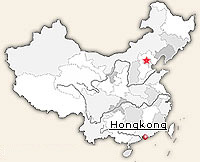Hong Kong Travel Guide
 Hong Kong, the Pearl of East and jewel of the Orient is famous for its gold and foreign exchange market, natural deep water harbour, commercial trade, toy manufacturing industry and ?film and service industries.
Hong Kong, the Pearl of East and jewel of the Orient is famous for its gold and foreign exchange market, natural deep water harbour, commercial trade, toy manufacturing industry and ?film and service industries.
Hong Kong is located in south China by the Guangdong province. It is separated from the mainland by a natural harbour.? ?Hong Kong consists of four parts, Hong Kong island, Kowloon Peninsula, the New Territories and 260 surrounding smaller islands and overall covers an area of 1095 square kilometres.??Hong Kong island and Kowloon Peninsula are the political, economic, cultural and traffic hub of Hong Kong. Hong Kong is 8 hours ahead of Greenwich Mean Time and is on the other side of the international Date Line (eastern hemisphere), this means people lose one day when travelling from countries in the western hemisphere, such as the US.
Hong Kong is a bridge that connects east and west. Various religious groups such as Christian, Buddhist, Confucian, Taoist, and other religious groups all co-exist in harmony in Hong Kong.?? Ancient Chinese traditions such as the Dragon Boat Festival, Tomb-sweeping Day and Festival of Lanterns are celebrated and revered in Hong Kong.
History
221 BC - First records in Chinese history of the territory which is now known as Hong Kong. The islands saw many transformations during the following thousands of years.
The first Opium War ended in 1841 with the Treaty of Nanking.? This resulted in Hong Kong Island being ceded to Britain and five other ports licensed for foreign trade.Under the Convention of Peking in 1860 during the second Opium War, the Kowloon peninsula was ceded to Britain. In 1898, the British acquired the New territories from China on a 99-year contract. The British controlled Hong Kong from then on - apart from a four-year period during World War II when the territory was occupied by the Japanese - until Hong Kong¡¯s handover in July 1997.
Hong Kong also plays an important part in international trading.?? There are many famous branded names available and range from electronic devices to clothing, cosmetics and toys. These all combine to make Hong Kong a shopper's haven at affordable prices.
Population
Statistics from the Hong Kong SAR government in 2005 shows that Hong Kong has an population of more than 7.2 million, with 6557.4 people per square kilometre. Amongst the 7.2 million population, 98% of them are Chinese and 2% of them are foreigners. Chinese and English are the official languages in Hong Kong, with Cantonese being the most widely spoken.
Music
Hong Kong is a part of China that has produced a number of popular traditions, including a large part of what is known as Cantopop. Cantopop is a kind of pop music, sung in Cantonese. There is also a long tradition of Cantonese opera in Hong Kong.
Movie
Hong Kong has one of the largest film industries in the world. Hong Kong's film industry is characterized by short production schedules, opportunistic use of locations and the following of distinctive Hong Kong genres. Film stars of the current genre, which is associated with martial arts and action, include Jackie Chan and Jet Li. In general, themes of Hong Kong films are narrower in range, and often actors are the key marketing tool of the local movies.
Shopping
When it comes to a serious shopping experience, Hong Kong has everything in abundance and more!
Hong Kong's malls, department stores and designer boutiques offer an amazing contrast to the many bustling open-air markets nestled among towering skyscrapers.
Save time and money with the latest shopping tips and discover where to shop to get the best deals around.
Hong Kong during a sales period is a complete retail therapy course! ?During the winter (late December to February) and the summer sale (July to September) major discounts are available for the avid shopper and bargain hunter.
Business and Money
Hong Kong is characterized by its high degree of internationalisation, business-friendly environment, rule of law, free trade and free flow of information, open and fair competition, well-established and comprehensive financial networks. Added to these are substantial foreign exchange reserves, a fully convertible and stable currency, and a simple tax system with low tax rates.